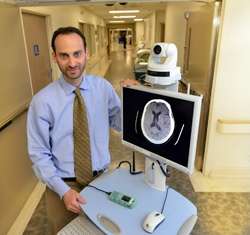Telestroke networks can be cost-effective for hospitals, good for patients

Telestroke networks that enable the remote and rapid diagnosis and treatment of stroke can improve the bottom line of patients and hospitals, researchers report.
A central hub hospital delivering rapid stroke diagnosis and treatment partnering with typically smaller spoke hospitals in need of those services means more patients recover better and the network – and hospitals – make money, according to a study in the American Heart Association journal Circulation: Cardiovascular Quality and Outcomes.
"We measure stroke treatment in reduced disability and improved function and we have clear evidence that patients who get timely intervention do best," said Dr. Jeffrey A. Switzer, stroke specialist at the Medical College of Georgia at Georgia Health Sciences University.
"If you are hospital administrator, you may like the idea conceptually but you have to be concerned about the risks of investing up front to do this. This is the first study to show that if it's set up correctly, a telestroke network will more than pay for itself."
Switzer is corresponding author on the study using five years of patient and hospital data from telestroke networks at GHSU and the Mayo Clinic. Researchers plugged the data into a model designed to compare effectiveness and hospital costs with and without a telestroke network. The telestroke model has one hub and seven spokes, the average network size in the United States.
They found that annually with a network:
- 45 more patients would receive the clot buster tPA, or tissue plasminogen activator, the only Food and Drug Administration-approved stroke drug
- 20 more patients would receive endovascular therapy such as mechanically removing the clot from a blood vessel
- Six more patients would be discharged to their home instead of a nursing home
- The network made nearly $360,000, with each spoke hospital making more than $100,000
The study suggests it is. It supports a model emerging across the nation, where large, hub hospitals such as GHS Medical Center pay equipment and other costs smaller hospitals incur using their network. In the vast majority of cases, patients are seen via the network by stroke specialists in Augusta, eligible patients are given tPA at the spoke hospital then transported to GHS Health System for follow-up care. A new iteration in recent years has larger, urban hospitals also utilizing the guaranteed acute stroke care but keeping most patients at their hospital afterward. The larger hospitals pay for their own telestroke equipment but also receive larger reimbursement from public and private insurance for their service, benefiting hospitals and patients, Switzer said. "Patients receive quality care and can stay closer to home."
A major driver behind these types of stroke-care extenders is a lack of stroke specialists. Georgia, for example, is nestled in the stroke belt and has less than 20 fellowship-trained stroke specialists to treat a population of 10 million. Each year only 50-60 stroke specialists complete training at centers across the nation such as MCG and GHS Health System.
The long-distance approach appears to work well: MCG researchers showed in a 2003 study published in the journal Stroke that stroke patients in rural communities could be assessed and treated via the wireless Internet program just as well as they could be in person.
While tPA has been FDA-approved for 16 years, still fewer than 5 percent of patients receive it, often because they don't get a definitive stroke diagnosis within the three-hour time frame the drug should be given. Three separate clinical trials in the United States and Europe have shown it improves the likelihood of patients resuming normal or near-normal lives.
Dr. David Hess, stroke specialist and Chair of the MCG Department of Neurology, helped developed the Augusta system a dozen years ago, initially connecting with a small number of rural hospitals. Today, GHS Health System serves as the hub for 17 spokes. The biotech company, REACH Health, Inc., emerged about six years ago to help other hospitals and states develop similar networks.















